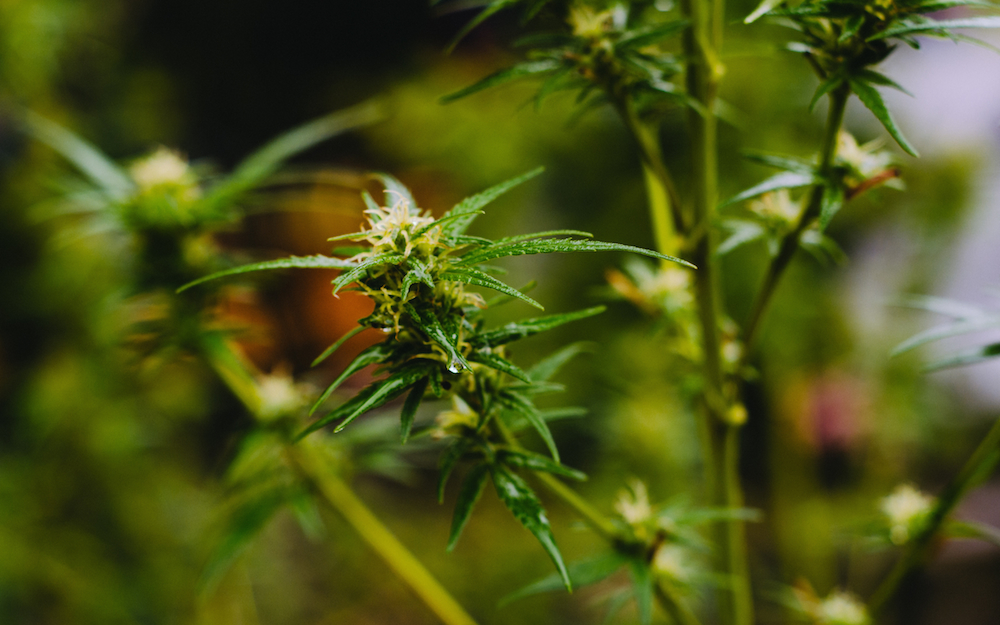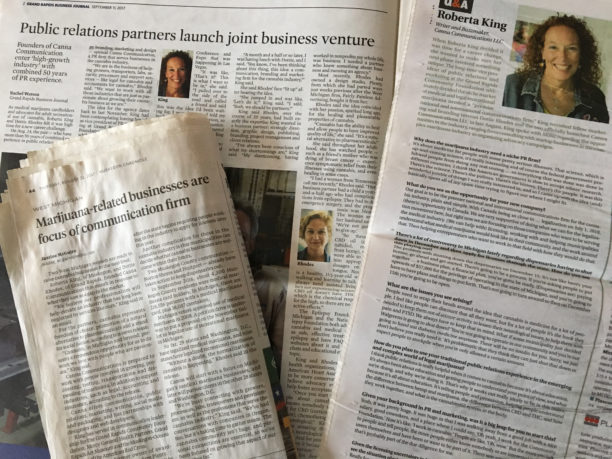In the mix of communication tactics, business owners have multiple options from traditional advertising to social media and everything in between, but for quick results and a big bang, nothing beats using PR for promoting cannabis brand. Media relations is part of the PR package and it is great for reaching new audiences beyond your social media circle.
It might feel like traditional media is out of reach, but if you have a good story and are willing to pitch and follow up, the benefits are immense.
Here’s the story about how PR helped the start-up of Park Place Provisionary by Agri-Med and garner significant news coverage.
Park Place Provisionary is a locally-owned medical marijuana provisioning center in Muskegon, Michigan. It is also the first state-licensed center in the county and one of just a few on the in West Michigan. Those two things are notable and newsworthy and here’s why.
Increasingly, medical marijuana businesses in Michigan are owned by people who live outside the community. That’s because Michigan municipalities, for the most part, have opted-out of the zoning that allows them. So, with fewer places to locate, marijuana entrepreneurs are spreading out across the state and coming into communities where they have no connection.
We’ve seen it in Grand Rapids, Michigan’s second largest city where it is estimated that of the 80+ applicants for medical marijuana permits less than five are city residents. We’re not going to debate local ownership in this post. That being said, we think local ownership is the best option for a community.
The strategy we used to write the press release and make the pitch focused on local ownership and being the first to open in the market. We were able to use that hook to attract the attention of not only the Muskegon media but television stations in Grand Rapids, too.

Here’s some of the text from the press release and I’ve highlighted parts that made this newsworthy.
Highlights of the Press Release
The provisioning center located at 1922 Park Street in Muskegon is owned by Muskegon resident and long-time business owner Greg Maki. Maki bought and renovated an old trucking and freight terminal for the provisioning center.
The building has undergone extensive renovation, connecting with city water and sewer, landscaping, lighting, and comprehensive security and surveillance, making the building secure, compliant and accessible. Located in Muskegon’s marijuana overlay district, Maki’s business is the first to be completed and opened in Muskegon.
“It’s great to be able to open my business in the place where I live. Being part of the community helped with everything from securing the property to working on-site every day to finding local contractors,” said Maki. Part of his motivation for getting into medical marijuana was to create a business where his sons and other close family members would want to work. His nephew Aaron Smith is the financial manager and his partner Tracy Powers is vice president. Other company leaders include non-family members. Charles Bronkema is the operations manager, and Cindy Devenport is Park Place’s compliance manager. In all 13 new jobs were created at the facility.
Agri-Med was the 9th applicant for a medical marijuana license when the state began licensing in December 2017; it was the 5th prequalified license that the state issued.
Hooks and Visuals for Cannabis PR
Park Place Provisionary was lucky to have so many good hooks: local, family and first. The media used those and also focused on the building renovation and how marijuana was improving a languishing industrial park in Muskegon.
We also created a small event, a ribbon cutting and grand opening for the store. It’s traditional for new businesses to cut a ribbon, and doing this at Park Place Provisionary helps normalize cannabis to people in the community. A ribbon cutting also allows the business owner to invite family, friends, elected officials and community leaders to gather and be part of the celebration.

In public relations terms—the event and announcement was a home run. We garnered coverage from three television stations, several local newspapers and a public radio station, a business paper and an online hyperlocal news site. It’s a great example of how using PR for promoting a cannabis brand can bring new customers.
The initial impact was good for Park Place—they went from seeing about 20 customers in the first few days of the soft opening to a peak of more than 100 after the ribbon-cutting. Keeping the momentum is the next step—communicating with patients via text and email, using social media and cannabis digital outlets to grow the business. And always looking for the next story to share with the media.
Results
Here are some of the links to the media stories that Canna Communication secured for Park Place Provisionary showing how using PR for promoting a cannabis brand can work and the messages that come across.
From Mlive, Muskegon’s newspaper and online news source. Another story was on West Michigan’s ABC affiliate, WZZM 13. The store also was featured on the local Fox affiliate, Fox17. Park Place Provisionary was also on the air at West Michigan’s public radio station WGVU.
Muskegon Times Muskegon’s online hyperlocal news site wrote this story.
WOODTV8 West Michigan’s NBC affiliate did an advance before the grand opening.
Let’s Talk About Your Cannabis PR
If you are opening a new facility or have another story to share related to your cannabis business or want to explore how using PR for promotion your cannabis brand can help you grow give us a call.
Public relations is our specialty. Contact Roberta F. King, APR to get the conversation started.



 to marijuana is compliant with local and state laws. You don’t want to do anything that would jeopardize your license, whether that is onsite consumption, giving away product or serving alcohol in your space.
to marijuana is compliant with local and state laws. You don’t want to do anything that would jeopardize your license, whether that is onsite consumption, giving away product or serving alcohol in your space.  and easy to eat. Keep in mind the time of your event, 5-7 PM is the dinner hour and people might expect heavier foods, 7-9 PM might lend itself to desserts and mid-afternoon is great for veggies, cheeses and crackers. Keep in mind food preferences like vegetarians and allergies like gluten and provide options. Label your food and make sure your troubleshooter knows what’s in the food you’re serving. If you’re serving infused food make sure it’s clearly labeled with potency and that you’re not outside the law.
and easy to eat. Keep in mind the time of your event, 5-7 PM is the dinner hour and people might expect heavier foods, 7-9 PM might lend itself to desserts and mid-afternoon is great for veggies, cheeses and crackers. Keep in mind food preferences like vegetarians and allergies like gluten and provide options. Label your food and make sure your troubleshooter knows what’s in the food you’re serving. If you’re serving infused food make sure it’s clearly labeled with potency and that you’re not outside the law.
 Undoubtedly, you’re wondering about how to get 2000 email addresses, and you are also aware that spamming people is wrong. Is it illegal? It depends on what you are saying, how you came by the email address and your intention. Writing a subject line that is intended to deceive people is spam. Sending an email to someone you met at a networking event isn’t spamming. Using a bot to gather up email addresses and sending something to thousands of people you have no relationship with is spamming. People in your database will have the ability to opt out of your emails, so sending to them is fine. Most providers (like MailChimp) have all the anti-spam requirements built into the software. The
Undoubtedly, you’re wondering about how to get 2000 email addresses, and you are also aware that spamming people is wrong. Is it illegal? It depends on what you are saying, how you came by the email address and your intention. Writing a subject line that is intended to deceive people is spam. Sending an email to someone you met at a networking event isn’t spamming. Using a bot to gather up email addresses and sending something to thousands of people you have no relationship with is spamming. People in your database will have the ability to opt out of your emails, so sending to them is fine. Most providers (like MailChimp) have all the anti-spam requirements built into the software. The  One of the most important aspects of cannabis business email marketing is the subject line. What are you going to say to get people to open your message and act? Make it short around 65 characters, use emojis carefully and make it intriguing. If you wonder if it will work, do an AB test with your list. Send half of the messages with one subject line (a) the rest with another (b) and see which gets a better open rate.
One of the most important aspects of cannabis business email marketing is the subject line. What are you going to say to get people to open your message and act? Make it short around 65 characters, use emojis carefully and make it intriguing. If you wonder if it will work, do an AB test with your list. Send half of the messages with one subject line (a) the rest with another (b) and see which gets a better open rate.
 needs circulated air, specific food at certain times. You don’t want it to cross-pollinate with other plants and it’s vulnerable to a variety of issues that can ruin it. Killing a plant that is as valuable as cannabis is a mistake no grower wants to make. Growers also don’t want to create a sub-par flower. That’s a lot of pressure!
needs circulated air, specific food at certain times. You don’t want it to cross-pollinate with other plants and it’s vulnerable to a variety of issues that can ruin it. Killing a plant that is as valuable as cannabis is a mistake no grower wants to make. Growers also don’t want to create a sub-par flower. That’s a lot of pressure!
 the millions, you can’t beat the mainstream media for getting your message to people.
the millions, you can’t beat the mainstream media for getting your message to people.  Content creation is hard work, but it’s essential. Your website’s SEO and social media depend on new, original, relevant and fresh content—which can be blogs, videos or images. Ideally, you’ll create new content once a week, but that can be a struggle without ideas, a plan or professional help.
Content creation is hard work, but it’s essential. Your website’s SEO and social media depend on new, original, relevant and fresh content—which can be blogs, videos or images. Ideally, you’ll create new content once a week, but that can be a struggle without ideas, a plan or professional help. 

 there.This is where you explore your potential audiences, your competition, the landscape of legislation and how people are reacting to what you are doing. You can read articles on a topic you want to know more about, you can ask questions of people who are potential customers; you can do a Survey Monkey or a poll on Twitter or Facebook.
there.This is where you explore your potential audiences, your competition, the landscape of legislation and how people are reacting to what you are doing. You can read articles on a topic you want to know more about, you can ask questions of people who are potential customers; you can do a Survey Monkey or a poll on Twitter or Facebook.
 Want to learn more about public relations for your cannabis business and how to expand your reach? Let’s talk!
Want to learn more about public relations for your cannabis business and how to expand your reach? Let’s talk!
 businesses.
businesses.